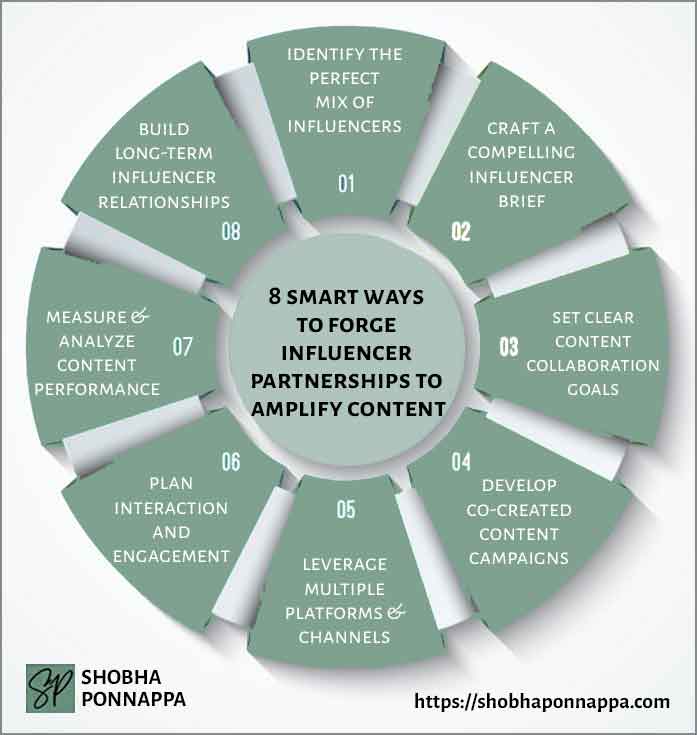
The challenge of standing out amidst a sea of content has become increasingly daunting – and the solution often lies in leveraging the power of influencer partnerships with well-networked individuals.
This approach not only amplifies your content but also adds a layer of authenticity and trustworthiness.
However, to truly maximize the potential of such collaborations, it’s essential to strike a balance between conventional tactics and more unconventional, creative strategies.
This blend ensures that your content not only reaches a wider audience but also resonates in a unique and memorable way, setting your brand apart in the crowded digital space.
Partnering with influencers offers brands a dynamic way to amplify their content and reach wider, more engaged audiences. Influencers, with their established followings and credibility in specific niches, act as powerful conduits for brand messages, providing access to a pre-engaged audience that is often difficult to reach through traditional marketing channels.
This collaboration can take various forms, from sponsored content and product reviews to co-created content, each offering unique opportunities to tap into the influencer’s loyal following. The authenticity and trust influencers have with their audience translate into higher engagement rates, making influencer partnerships a valuable tool for increasing brand visibility and credibility.
Furthermore, leveraging influencers’ creative expertise can bring fresh perspectives to a brand’s content strategy, helping to craft messages that resonate more deeply with target audiences.
Such partnerships, when strategically aligned with brand values and goals, not only enhance content reach but also foster meaningful connections with consumers, driving both brand awareness and loyalty
Building influencer partnerships requires a blend of proven methods and unconventional ideas, a concept central to my “Unusual By Strategy” forte. This approach emphasizes the importance of not just relying on established techniques but also incorporating novel, creative strategies to stand out in a saturated market.
While traditional tactics like audience targeting and aligning with influencers who share brand values are foundational, infusing unique elements can significantly enhance the impact. For instance, partnering with influencers in non-traditional niches or experimenting with innovative content formats can capture attention in unexpected ways.
This methodology isn’t just about being different for the sake of it; it’s a strategic choice to blend the reliability of proven methods with the freshness of unconventional ideas.
Such a combination ensures that influencer partnerships are not only effective in reaching and engaging audiences but also memorable, reinforcing brand uniqueness and driving deeper audience connections.
Leveraging my 40+ years’ experience as a Brand Content Strategist with a penchant for the unusual, I have compiled eight ideas below. These ideas not only utilize the strengths of traditional methods but also incorporate unique, creative strategies that make these ideas work even harder.
This blend ensures that while the foundational aspects of influencer partnerships are respected, the added unconventional elements bring a fresh dynamic, setting your brand’s content strategy apart in a competitive digital landscape.

Selecting the right influencers is a critical step in amplifying content effectively, requiring a keen understanding of both the brand’s audience and the influencer’s reach. A well-chosen influencer not only has a substantial and engaged following but also shares a natural affinity with the brand’s values and messaging.
For example, a health food company might partner with a fitness influencer known for their wholesome lifestyle and authentic engagement with health-conscious followers. This synergy ensures that the content resonates with the influencer’s audience, leading to higher engagement and a stronger impact.
Additionally, it’s crucial to consider a mix of influencer types – from micro-influencers with niche, loyal communities to macro-influencers with broader appeal – to cover different segments of the target market. By meticulously curating this mix, brands can effectively disseminate content across varied demographics, increasing reach and relevance.
This strategy, deeply rooted in the principles of content marketing, leverages the influencer’s credibility to enhance brand visibility, fostering trust and connection with the audience.

Consider the idea of “Influencer Role Reversal.” This unusual enhancement involves temporarily switching roles, where influencers take on the role of content strategists for your brand, while your team adopts the influencer persona. This approach allows for fresh perspectives in content creation and strategy.
For instance, in the case of the health food company partnering with a fitness influencer, the influencer could temporarily take charge of the brand’s content strategy, suggesting innovative content ideas based on their intimate understanding of the target audience. Simultaneously, the brand’s team could engage with their audience as influencers, providing insights into the brand’s ethos and behind-the-scenes. This role reversal can lead to novel content approaches and deeper audience engagement.
Crafting a compelling influencer brief is a critical step to ensure both the influencer and the brand are on the same page regarding expectations and objectives. A well-constructed brief outlines the campaign goals, target audience, key messaging, and desired outcomes, providing clear direction while allowing the influencer creative freedom.
For example, a sustainable fashion brand might collaborate with an eco-conscious lifestyle influencer. Their brief would detail the brand’s mission, the importance of sustainable practices, and the specific product range to be promoted, while also encouraging the influencer to integrate their personal storytelling and unique content style.
This ensures the content is authentic to the influencer’s voice, which is crucial for audience engagement, and aligns with the brand’s content marketing strategy.
The brief should also include practical details like content formats, posting schedules, and any hashtags or links to be used, ensuring a smooth collaboration and effective amplification of content across platforms.

Consider the idea of “Dynamic Briefing.” This unusual enhancement involves creating an interactive, evolving brief that adapts based on ongoing feedback and results. Instead of a static document, the brief becomes a collaborative, living guide that both the influencer and brand can modify. For instance, in the sustainable fashion brand example, as the influencer begins to post content, they can provide real-time insights into audience reactions and engagement.
This feedback can then be used to tweak the messaging, content style, or even campaign objectives in the brief. Such dynamic briefing allows for more agile and responsive content strategies, ensuring the campaign remains relevant and impactful as it progresses.
Setting clear content collaboration goals is pivotal in ensuring that both the brand and the influencer work towards a common objective, thereby maximizing the impact of the campaign. These goals should be specific, measurable, achievable, relevant, and time-bound (SMART).
For instance, a tech company aiming to promote a new smartphone might partner with a tech influencer. Their collaboration goals could include increasing brand awareness by 20% among tech enthusiasts within three months, generating 10,000 engagements on the influencer’s campaign posts, and driving 5% conversion in terms of website visits or pre-orders from the influencer’s content.
Clearly defined goals help the influencer understand what success looks like and enable the brand to measure the effectiveness of the campaign.
This step is a cornerstone in content marketing, as it aligns the influencer’s creativity with the brand’s marketing objectives, ensuring cohesive and effective messaging across all platforms.

Consider the idea of “Goal Gamification.” This unusual enhancement involves introducing game-like elements into the goal-setting process of content collaboration. By turning goals into challenges or competitions, both the influencer and the brand can engage more dynamically. For example, in the tech company and influencer collaboration, goals like increasing brand awareness or generating specific engagement numbers could be transformed into a series of challenges.
Each achieved milestone could unlock rewards or lead to the next level of collaboration, such as exclusive content or special promotions. This gamified approach not only makes the process more engaging but also fosters a spirit of creativity and enthusiasm, potentially leading to more innovative and effective content.
Developing co-created content campaigns with influencers is a strategy that brings together the strengths of both the brand and the influencer, resulting in more authentic and engaging content.
This collaborative approach allows influencers to infuse their creativity and understanding of their audience into the brand’s messaging, creating content that resonates more deeply with the audience. For example, a beauty brand could collaborate with a makeup artist influencer to create a series of tutorial videos.
The influencer could offer their expertise and style, while the brand provides the products and overarching message. This partnership not only showcases the product in a practical, relatable way but also leverages the influencer’s credibility and rapport with their followers.
Such campaigns enrich content marketing efforts by blending the influencer’s personal touch with the brand’s objectives, resulting in content that is both genuine and effectively aligned with the brand’s marketing goals.

Consider the idea of “Reverse Brand-Influencer Roles.” This unusual enhancement involves the brand taking on the role of content creator in the influencer’s typical style, while the influencer adopts a brand-centric approach. In the case of the beauty brand and makeup artist influencer collaboration, the brand could create content in the influencer’s signature style, perhaps producing a behind-the-scenes look at product creation or a brand story video.
Simultaneously, the influencer could take a more direct role in showcasing the products, perhaps by curating a special product line or presenting a webinar on beauty trends. This role reversal not only adds an element of novelty and surprise to the campaign but also deepens the understanding and connection between the brand and the influencer, resulting in more authentic and engaging content.
Leveraging multiple platforms and channels is essential in maximizing the reach and impact of influencer partnerships. By diversifying the platforms used, brands can tap into varied audience segments and enhance engagement across different demographics.
For example, a sportswear brand partnering with a fitness influencer might use Instagram for visual content like photos and short videos, YouTube for detailed workout guides, and Twitter for quick updates or Q&A sessions.
This multi-channel approach ensures that the content reaches a broader audience, catering to platform-specific preferences and behaviors. It’s not just about spreading content across different mediums; it’s about tailoring the message to suit each platform’s unique style and audience.
This strategy amplifies the content’s reach, making the influencer-brand collaboration more effective and allowing the brand to leverage the full spectrum of digital marketing channels, thereby reinforcing its presence in the diverse landscape of online content consumption.

Consider the idea of “Cross-Platform Storytelling.” This unusual enhancement involves creating a continuous narrative that unfolds across different platforms, each segment adapted to the unique style of the respective channel. In the case of the sportswear brand and fitness influencer collaboration, the story might start with a teaser video on Instagram, evolve into a detailed workout session on YouTube, and culminate in a live Q&A on Twitter.
Each platform segment adds a layer to the narrative, engaging the audience in a multi-dimensional story. This approach not only leverages the strengths of each platform but also keeps the audience engaged across different channels, creating a holistic and immersive brand experience.
Planning engagement and interaction strategies is crucial in amplifying the impact of influencer collaborations. This involves creating a roadmap for how the audience will interact with the content and how the influencer and brand will engage with the audience in return.
For example, a gourmet coffee brand might collaborate with a food influencer to promote a new coffee blend. The strategy could include the influencer hosting a live coffee tasting session on Instagram, followed by a Q&A about coffee flavors and brewing techniques.
The brand, meanwhile, could engage by responding to comments, sharing user-generated content, and offering exclusive discounts to viewers. This two-way interaction not only increases engagement rates but also builds a sense of community around the brand, making the content more relatable and memorable.
It’s about turning passive viewers into active participants, thereby deepening their connection with the brand and enhancing the overall effectiveness of the content marketing campaign.

Consider the idea of “Narrative Immersion Engagement.” This unusual enhancement revolves around creating an interactive story where the audience’s actions and choices influence the content’s direction. In the case of the gourmet coffee brand, this could involve the audience voting on different aspects of the influencer’s coffee-tasting session, such as choosing the coffee blend or brewing method.
The influencer then creates content based on these choices, perhaps even hosting a live session where these preferences are put into action. This strategy not only increases engagement through interactive elements but also makes the audience feel like an integral part of the content creation process, deepening their connection with the brand and the influencer.
Measuring and analyzing content performance is a critical aspect of influencer collaborations, providing insights into the effectiveness of the campaign and guiding future strategies. Key metrics such as engagement rates, reach, impressions, click-through rates, and conversion rates offer a quantitative assessment of how the content resonates with the audience.
For instance, a skincare brand collaborating with a beauty influencer to promote a new product line would track specific metrics like the number of website visits, duration of engagement with the posts, and sales generated through influencer-specific promo codes.
This data not only measures the immediate impact of the campaign but also provides valuable insights into audience preferences and behaviors. Analyzing these metrics helps in fine-tuning content strategies, optimizing influencer selection, and improving overall content marketing efforts.
It ensures that the brand’s investment in influencer marketing is justified and contributes to achieving its broader marketing objectives.

Consider the idea of “Emotive Response Analysis.” This unusual enhancement involves going beyond traditional metrics to assess the emotional impact of the content on the audience. By using advanced analytics tools that can interpret comments and reactions for sentiment analysis, brands can gain deeper insights into how the audience emotionally connects with the content.
In the case of the skincare brand and beauty influencer collaboration, apart from tracking standard metrics like engagement and conversions, they could analyze the tone and sentiment of comments and feedback. This approach provides a more nuanced understanding of audience perceptions and reactions, allowing for more emotionally resonant and effective future campaigns.
Building long-term influencer relationships is crucial for sustained content marketing success, as it fosters deeper, more authentic collaborations over time. These enduring partnerships allow for a more integrated approach to content creation, where influencers become genuine advocates for the brand.
For example, a travel company could build a long-term relationship with a travel blogger, involving them in various campaigns throughout the year. This continuous collaboration enables the blogger to develop a more profound understanding of the brand’s values and messaging, leading to content that resonates more naturally with their audience.
Over time, their followers begin to associate the blogger’s travel adventures with the brand, building trust and loyalty.
Such long-term partnerships also provide opportunities for feedback and mutual growth, allowing both the influencer and the brand to evolve their strategies and content in a way that consistently engages the audience and drives meaningful results.

Consider the idea of “Shared Journey Storytelling.” This unusual enhancement involves documenting and sharing the evolving story of the brand-influencer relationship over time, making the audience a part of this journey. In the context of the travel company and travel blogger example, this could mean creating a series of behind-the-scenes content that showcases the growth and milestones of their collaboration.
This might include the initial meeting, planning sessions for various campaigns, and reflections on past successes and learning experiences. This approach not only adds depth to the relationship but also engages the audience more intimately, making them feel like a part of the ongoing narrative between the brand and the influencer.
Strategic influencer selection: The importance of carefully choosing influencers who align with your brand’s values and audience cannot be overstated. This alignment is crucial for creating authentic and engaging content that resonates with both your target audience and the influencer’s followers.
Collaborative content creation: Co-creating content with influencers ensures that the content is not only promotional but also authentic and engaging. It leverages the influencer’s creativity and connection with their audience, leading to higher engagement and a stronger impact.
Long-term relationships for sustained success: Building lasting relationships with influencers is more beneficial than one-off campaigns. Long-term collaborations allow for deeper integration of influencers with your brand and result in more consistent and impactful content that effectively amplifies your brand message over time.

"As a Content/Brand Specialist, and SEO/UX Writer, I can help transform your brand's online presence. I can lift it with innovative ideas to take it to an enviable position. Let's collaborate to create a captivating brand story, engage your audience, boost your online visibility, and increase your ROI. Take the next step towards your brand content success and contact me today."
Shobha Ponnappa
I Bring You:
Content Marketing That’s “Unusual By Strategy” … Tips, Tricks, Tactics, Techniques, Trends, Training.
Get my weekly ContenTracker Newsletter packed with loads of content marketing ideas – proven and unusual.
Get a free download of my ebook on “50 Unusual Ways To Use AI In Content Marketing” … and transform your success.

Just fill in the form to join my community … we have big and small brands for company. You’ll stay on the speedway to growth.
KEY TOPIC CATEGORIES COVERED ON THIS SITE:
COPYRIGHT © 2025. SHOBHAPONNAPPA.COM. ALL RIGHTS RESERVED.

Just fill in this form and get this awesome guide via email. Plus … each fortnight you’ll receive my Brand Reframe Newsletter that brings you smart insights, distilled thinking, and focused brand momentum.